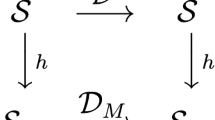Abstract
The questions of observational error and ambiguity of interpretation that have been raised in connection with the reported observation of a magnetic monopole have precipitated a situation calling for some further insight into the pairing principles of nature. A basic distinction relates to whether or not a pair is “ordered” (e.g., sexual pair) or without a priori order (e.g., mirror pair). It is shown that the polarity of electric charge is to be regarded as an example of pairing without an intrinsic a priori order. It then follows that “action” also exhibits a pairing without a priori order. The relation ofPC andTC to unordered and ordered pairing is discussed, with neutral kaon pairing as a striking example of ordered pairing. The pairing of magnetic charge, if it exists, becomes an ordered pairing!
Similar content being viewed by others
References
L. W. Alvarez, Analysis of a Reported Magnetic Monopole, Lawrence Berkeley Laboratory Report LBL 4260 (September 16, 1975); Invited talk, Stanford International Conference on Leptons and Photons (August 27, 1975), response to a paper by Price, Shrik, Osborne, and Pinsky,Phys. Rev. Lett. 35, 487 (1975).
J. Schwinger,Phys. Rev. 74, 1439 (1948); R. P. Feynman,Phys. Rev. 76, 749 (1949).
C. Truesdell and R. A. Toupin, inHandbuch der Physik, Vol. III/I (Springer, Berlin-Heidelberg, 1960), pp. 666, 682.
E. Merzbacher,Quantum Mechanics, 1st ed. (Wiley, New York, 1962), p. 366.
F. A. Kaempffer,Concepts in Quantum Mechanics (Academic Press, New York, 1965), p. 101.
G. de Rham,Variétés Différentiables (Hermann, Paris, 1955), Chap. II, Sections 4 and 5.
J. A. Schouten,Tensor Analysis for Physicists (Clarendon Press, Oxford, 1951), Chap. VII, Sections 5 and 6.
E. J. Post,Phys. Rev. D 9, 3379 (1974).
A. Einstein,Verhandl. Dtsch. Physik. Ges. 19, 82 (1917).
P. A. M. Dirac,Can. J. Math. 3, 1 (1951).
Author information
Authors and Affiliations
Additional information
This work has been partially supported by the British Research Council through the University of Salford, England.
In a paper to appear in this journal, R. M. Kiehn, University of Houston, considers eight formal possibilities for parity and time inversion conventions. By imposing varied physical restrictions, the eight possibilities reduce to a selected few that have been used or proposed at some time. One of these eight conventions (listed as number 2) is based on a full validity of a spacetime Neumann principle: It is the subject of discussion in the present paper. This proposal has been previously presented in seminars at the Universities of Salford, Houston, Southern California, and Boston, as well as at the 1974 fall meeting on elementary particles and relativity in Austin, Texas.
Rights and permissions
About this article
Cite this article
Post, E.J. A minor or a major predicament of physical theory? (Charge and action polarity and their order properties). Found Phys 7, 255–277 (1977). https://doi.org/10.1007/BF00709011
Received:
Issue Date:
DOI: https://doi.org/10.1007/BF00709011




